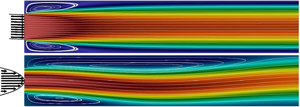Article contents
Influence of the inlet velocity profile on the flow stability in a symmetric channel expansion
Published online by Cambridge University Press: 22 December 2020
Abstract

In a channel flow with a sudden expansion, whether for three-dimensional (3-D) pipe and channel flows, or for two-dimensional (2-D) channel flow, it is known that increasing the Reynolds number beyond a critical value  $Re_c$ induces a symmetry breaking Pitchfork bifurcation. The linear stability analysis of the symmetric steady solution enables the
$Re_c$ induces a symmetry breaking Pitchfork bifurcation. The linear stability analysis of the symmetric steady solution enables the  $Re_c$ to be determined efficiently and thus the influence of the expansion ratio (
$Re_c$ to be determined efficiently and thus the influence of the expansion ratio ( $ER$), defined as the ratio between upstream and downstream diameter regarding the expansion, to be explored. In this study, we investigate the behaviour of the flow after 2-D sudden expansions while varying the
$ER$), defined as the ratio between upstream and downstream diameter regarding the expansion, to be explored. In this study, we investigate the behaviour of the flow after 2-D sudden expansions while varying the  $ER$ and the inlet flow profile, e.g. corresponding to a transition profile between a plug and a Poiseuille flow that could be reached for a flow after a sudden constriction upstream. Results demonstrate that imposing a plug flow at the inlet gives a higher
$ER$ and the inlet flow profile, e.g. corresponding to a transition profile between a plug and a Poiseuille flow that could be reached for a flow after a sudden constriction upstream. Results demonstrate that imposing a plug flow at the inlet gives a higher  $Re_c$ than any other profile and that the concomitant recirculation zones are shorter. We show that these results can be rationalized using basic convection–diffusion arguments.
$Re_c$ than any other profile and that the concomitant recirculation zones are shorter. We show that these results can be rationalized using basic convection–diffusion arguments.
- Type
- JFM Papers
- Information
- Copyright
- © The Author(s), 2020. Published by Cambridge University Press
References
REFERENCES
- 6
- Cited by



